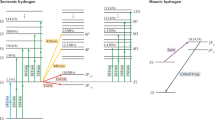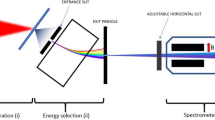Abstract
IN a recent paper, Holloway and Moore1 have given a curve showing the average specific ionization, as a function of the residual range, for protons in air. On this curve the ionization maximum occurs at 1.9 mm. residual/range, and in the course of the paper the absolute value of the maximum specific ionization is quoted as 2,320 ion pairs per mm. The shape of the ionization/range curve was deduced from earlier measurements of Parkinson, Herb, Bellamy and Hudson2, and the absolute value of the ionization was obtained on the assumption that, in the region of 3 cm. residual range, the mean specific ionization produced by a proton is a quarter of that produced by an α-particle of the same velocity. On this basis Holloway and Moore inferred that the maximum specific ionization is about one third as great for protons as for α-particles in air (6,760 ion pairs per mm.). Now, while there is overwhelming evidence for the correctness of this last assumption (the 1:4 ratio of ionizations for particles of the same velocity, when the ratio of the effective charges is constant at 1:2), it also appears that the conclusions, regarding the position and height of the ionization maximum for protons, to which the subsequent argument leads, run contrary to accepted evidence from other experiments. If this be admitted, then one must clearly assume that the results of Parkinson, Herb, Bellamy and Hudson will not bear the detailed analysis which Holloway and Moore place upon them, when protons of the smallest energy are concerned. It is the object of the present note to point out the contrary evidence referred to above.
This is a preview of subscription content, access via your institution
Access options
Subscribe to this journal
Receive 51 print issues and online access
$199.00 per year
only $3.90 per issue
Buy this article
- Purchase on Springer Link
- Instant access to full article PDF
Prices may be subject to local taxes which are calculated during checkout
Similar content being viewed by others
References
Holloway and Moore, Phys. Rev., 58, 847 (1940).
Parkinson, Herb, Bellamy and Hudson, Phys. Rev., 52, 75 (1937).
Bower, Proc. Camb. Phil. Soc., 34, 450 (1938).
Holloway and Livingston, Phys. Rev., 54, 18 (1938).
Bethe, Phys. Rev., 53, 313 (1938).
Stetter and Jentschke, Z. Phys., 110, 214 (1938).
Rogers, F. T., and Rogers, M. M., Phys. Rev., 55, 263 (1939).
Chadwick and Goldhaber, Proc. Roy. Soc., A, 151, 479 (1935).
Chadwick, Feather and Bretscher, Proc. Roy. Soc., A, 163, 366 (1937).
Author information
Authors and Affiliations
Rights and permissions
About this article
Cite this article
FEATHER, N. Ionization Maximum for Protons. Nature 147, 510–511 (1941). https://doi.org/10.1038/147510a0
Issue Date:
DOI: https://doi.org/10.1038/147510a0
This article is cited by
-
On the Feasibility of Self-Sustainable Deuterium Production in Fusion Reactors Using an Ionization Chamber
Journal of Fusion Energy (2015)
Comments
By submitting a comment you agree to abide by our Terms and Community Guidelines. If you find something abusive or that does not comply with our terms or guidelines please flag it as inappropriate.



